Jurassic World: Fallen Kingdom (PG-13)
29/06/18 00:39 Filed in: 2018
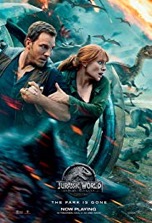
Starring: Chris Pratt
June 2018
Warning! This is NOT a movie review. This is a critique of the film. Intended to initiate a dialogue, the following analysis explores various aspects of the film and may contain spoilers. Views are my own and elaborate on comments that were originally tweeted in real time from the back row of a movie theater @BackRoweReviews. For concerns over objectionable content, please first refer to one of the many parental movie guide websites. Ratings are based on a four star system. Happy reading!
What we witnessed in Jurassic World (2015) was the fruition of John Hammond (Richard Attenborough) and Benjamin Lockwood’s (James Cromwell, who is egregiously underserved in this film) dream—a functioning dinosaur park filled with attractions, rides and, of course, gift shops. But midway through that movie, life found a way and the dinos started eating the tourists. At the beginning of the sequel, Jurassic World: Fallen Kingdom, the park lies in ruins and the remaining dinos are being threatened by a violent volcano that will soon incinerate the island. As experts on the dinos, Owen Grady (Chris Pratt) and Claire Dearing (Bryce Dallas Howard) are prevailed upon to help with the rescue effort. But the dino extraction goes south when a joint military (led by Ken Wheatley, Monk’s Ted Levine) and scientific (funded by greedy industrialist Eli Mills, played by Rafe Spall) operation brings the animals back to the mainland in a storyline that has far too many similarities to The Lost World: Jurassic Park (1997). The caged dinos are auctioned off (quite expertly by Toby Jones) to extremely rich and “discriminating” buyers. When a new hybrid species is introduced, the Indominus Rex crossed with Raptor “Indoraptor,” the bidders leverage their fortunes to own the priceless prototype dino. Dr. Henry Wu (BD Wong) protests, stating that the creature isn’t for sale, but Eli arrogantly quips, “Relax, we’ll make some more.” Of course, this “lack of humility before nature” is the cue for all hell to break loose…as it always does in the Jurassic films. JW2 retains many “popcorn” elements and actually has a plot…and message. Though the animal trafficking (and human/sex trafficking by extension) subplot is drilled home pretty hard, there’s also a subtle warning about how the dinos might be used for their biopharmaceutical properties. This opens up some fascinating and frightening possibilities. Could we discover new cures to diseases and make major advancements in medicine by studying the dinos? Could such knowledge also lead to the creation of virulent stains of chemical and bioweapons? As Ian Malcolm (Jeff Goldblum, who makes a brief cameo here) states in the film, “We’re causing our own extinction.” In an unexpected twist, Eli refers to Owen and Claire as the “parents of the future” since Claire authorized the creation of the Indominus Rex and Owen successfully trained raptors. This is a compelling outsider’s perspective on how their actions have unintentionally produced results antithetical to their beliefs. In essence, they’ve created their own monster. There are numerous allusions to the earlier films here, like the helicopter’s journey to the island, the side view mirror etched with “Objects in mirror are closer than they appear” (though, symbolically, the words are upside down this time) and the T-Rex’ triumphant bellow. There’s also a clever series of shots where the camera focuses on a character’s feet and then pans up. The first instance is when Claire is wearing high heels and the next is when she arrives on the island in boots. This corrects a major criticism of the previous film which had Claire running around the park in high heels. There are some fun scenes, like when the head-butting Stygimoloch sends party guests flying through the air as if they were gored by a bull, and some terrifying moments, like the Nosferatu (1922) style shot of the Indoraptor’s claw slowly reaching for the little girl hiding in her bed. In the end, JW2 is a surprisingly poignant chapter in the Jurassic saga that features far fewer gratuitous dino chases and more meaty and thought-provoking examinations of human greed and our irresistible need to play god. The way things end in JW2, JW3 may take place in your neighborhood.
Rating: 3 out of 4 stars
Deadpool 2 (R)
29/06/18 00:34 Filed in: 2018
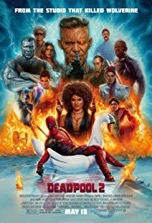
Starring: Ryan Reynolds
May 2018
Warning! This is NOT a movie review. This is a critique of the film. Intended to initiate a dialogue, the following analysis explores various aspects of the film and may contain spoilers. Views are my own and elaborate on comments that were originally tweeted in real time from the back row of a movie theater @BackRoweReviews. For concerns over objectionable content, please first refer to one of the many parental movie guide websites. Ratings are based on a four star system. Happy reading!
In Deadpool 2, the eponymous foul-mouthed superhero has returned to bring us a family film, or so he claims at the beginning of the movie. Don’t believe him. Even though writers Rhett Reese, Paul Wernick and some douche named Ryan Reynolds have toned down the violence and double entendres, the movie is still a bloody, crass, irreverent wad of inappropriateness. An early romance storyline quickly yields to a series of action sequences as the movie struggles to find its narrative footing. It isn’t until the Mystery Men (1999) style superhero tryout that the film begins to come into focus. The sequence is an absolute hoot, especially the heated exchange over whether or not luck should be considered a superpower. The debate is soon settled when Domino (Zazie Beetz) assists Deadpool in fending off some thugs…an amusing and unique action sequence which is basically Murphy’s Law in reverse. Josh Brolin, fresh off his stint as villain Thanos in Avengers: Infinity War, is the movie’s wild card and adds some much-needed heft and complexity to the film. Another pivotal character is Firefist (Julian Dennison), a young orphan who possesses powers he can’t control; which makes him equal parts innocent kid and unpredictable threat. In an obvious indictment against the Catholic Church, Firefist has been taken advantage of by the religious headmaster (Eddie Marsan) at a school for boys. Though you have to dig through the rubble to find it, this is the only real message in the film—i.e. the heinous sexual abuse of minors at many such institutions. Of course, there are plenty of humorous scenes in the film, like the fate of Wade’s new team on their first mission and when Wade grows back his legs after being ripped in half by Juggernaut. The action scenes, filmed with numerous Matrix-style slo-mo sequences, are well executed by director David Leitch. In particular, the sequence where Colossus (voiced by Stefan Kapicic) and Juggernaut slug it out reaches near epic proportions. The end credits scenes, where Wade uses a time machine to rectify the mistakes of the past (like when Reynolds first picked up the Green Lantern script) are the highlight of the film. Final analysis: D2 isn’t as crass or graphic as the first film, but isn’t as funny or clever either. Reynolds’ shtick is wearing pretty thin at this point (especially the VO narrations and frequent instances of breaking the fourth wall). The series needs to evolve; otherwise it might end up resembling its title. Not the pool part.
Rating: 2 ½ out of 4 stars
American Animals (R)
24/06/18 03:21 Filed in: 2018
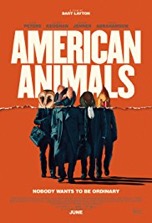
Starring: Ann Dowd
June 2018
Warning! This is NOT a movie review. This is a critique of the film. Intended to initiate a dialogue, the following analysis explores various aspects of the film and may contain spoilers. Views are my own and elaborate on comments that were originally tweeted in real time from the back row of a movie theater @BackRoweReviews. For concerns over objectionable content, please first refer to one of the many parental movie guide websites. Ratings are based on a four star system. Happy reading!
American Animals is the story of how four college-age men bungled their plan to steal some rare bird books in Lexington, Kentucky’s Transylvania University library. The premise sounds outlandish and fictitious. However, as the opening text emphatically states, the movie isn’t “based on” the real story, it is the real story. To ensure validity, director Bart Layton weaves canned interviews throughout the tapestry of the film. This creates a strange narrative flow between the documentary style interviews with the real-life criminals and the dramatized action with the actors portraying them. Other drawbacks are slow pacing and an initially confusing plot…interviewees reference the incident long before we learn the details of what happened on that fateful day in 2004. The film is packed with allusions to other movies, including the “bigger boat” quote from Jaws (1975) and the characters’ assumed aliases (Mr. Pink, etc.) which were inspired by Reservoir Dogs (1992). When things start to unravel during the heist—i.e. incapacitating the librarian and the plan B exit through the first floor stairwell—the film finally finds some energy and urgency. Much like the early stages of the movie however, the denouement is dragged out and many of the silent reaction shots, though emotionally impactful, are painfully long. The movie boasts a cast of talented young actors, headlined by Evan Peters, who plays Quicksilver in the newer X-Men movies. The only other recognizable face in the cast is Ann Dowd, who is best known for her work on TV’s The Leftovers and The Handmaid’s Tale. The most striking sequence in the film comes during the disguise prep scene when a close-up shot of one of the young men creating wrinkles around his eyes cuts to a painting of an owl (and how fascinating that a synonym for thief is owl). It’s a jarring, disturbing cut that hints at the animalistic impulses that are driving these characters toward baser behaviors. There’s a subtle inference that this transformation is also a psychological one (i.e. assuming the traits of different animals), but this potentially fascinating storyline is never explored. The film is a mishmash of themes including: youth is wasted on the young, anything that can go wrong will go wrong and crime doesn’t pay. The movie is also a conglomeration of many different plot elements like: art, crime, college life, documentary filmmaking, etc. This reveals the movie’s narrative indecisiveness—much like the young men it focuses on, the story is in search of an identity. In the end, AA is a unique film both in terms of its subject matter and story structure. If you’re looking for something different, this is it.
Rating: 3 out of 4 stars
Incredibles 2 (PG)
24/06/18 02:17 Filed in: 2018
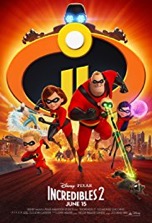
Starring: Craig T. Nelson
June 2018
Warning! This is NOT a movie review. This is a critique of the film. Intended to initiate a dialogue, the following analysis explores various aspects of the film and may contain spoilers. Views are my own and elaborate on comments that were originally tweeted in real time from the back row of a movie theater @BackRoweReviews. For concerns over objectionable content, please first refer to one of the many parental movie guide websites. Ratings are based on a four star system. Happy reading!
While waiting to watch Incredibles 2, I detected an insidious pattern in the previews. For The Lego Movie 2, Wyldstyle (Elizabeth Banks) admits that she almost singlehandedly saved the world in the first movie, but that Emmet (Chris Pratt) took all the credit. The next trailer was for Wreck-It Ralph 2. In a telling scene, Vanellope (Sarah Silverman) stumbles into a room full of Disney princesses who initially question her right to join them until they identify with her plight; people always assume that all of Vanellope’s problems will be solved as soon as a big, strong man shows up. When the feature presentation finally started, I thought for sure the anti-male bias was over—surely Pixar wouldn’t stoop to such shameless sexism, right? Wrong. It would appear that the sentiments behind the #MeToo and #TimesUp movements have now infiltrated kids’ movies…and that makes me mad. For a detailed diatribe of my stance against movies that seek to indoctrinate children with partisan political views, read my review of Happy Feet. Suffice it to say, unhealthy stereotypes of men are everywhere now, even in typically high-quality, high class Pixar pics. Case in point is Bob Parr/Mr. Incredible (Craig T. Nelson). If we thought Bob was emasculated at the beginning of first film as the deskbound, pencil pushing cube dweller, imagine how worthless he feels when his wife Helen Parr/Elastigirl (Holly Hunter) gets a crime fighting gig and he’s left at home to raise the kids Mr. Mom style. When Bob’s efforts to take care of his three kids go up in smoke (as a former accountant, he can’t even teach his son math because it’s “new math”), he reaches out to friend Frozone (Samuel L Jackson) for advice and prevails upon costume designer Edna (Brad Bird) to babysit Jack-Jack. Particularly disturbing is the cost analysis scene, which flags Mr. Incredible as an extreme insurance risk. The analytics reveal that Elastigirl (woman) completes her missions without bending a blade of grass, while Mr. Incredible (man) inflicts massive damage while attempting to defeat villains. Men are characterized as blundering buffoons who just can’t help but destroy everything in their path (much like Wreck-It Ralph or Hulk). So then, if Bob is a failure as a father and a superhero, what good is he? The last player in the NFL draft is referred to as Mr. Irrelevant. In I2, Bob Parr isn’t Mr. Incredible, he’s Mr. Irrelevant. Bob is the exemplar of the scores of men who’ve been sidelined and debased. Will it get to the point where men are nothing more than laborers and lovers in a matriarchal society, as was depicted in Gene Roddenberry’s Planet Earth (1974)? Time and societal evolution will tell, but as for now, we’re on the verge of the systematic censure, deconstruction and endangerment of the male of the species. Aside from gender roles, the movie also gets political when it deals with the integration of the Supers back into society; a topic that could relate to refugees from the Middle East, illegals pouring over the border from Mexico or even the way the LGBT community is being assimilated into the broader populace. The movie also makes thinly-veiled commentary about our growing screen obsession. Staring at one of villain Screenslaver’s hypnotic patterns can override a person’s will and make them highly susceptible to committing evil acts. Walk into any public place and you’ll see people with their faces buried in screens, in essence hypnotized by onscreen content and completely oblivious to what’s going on around them. The parallel is obvious; the solution isn’t. It’s ironic that this problem was in its initial stages when The Incredibles was released in 2004. Despite its broad spectrum of commentary, the film does have some fun, although not nearly as much as the original. Even though the scenes with Jack-Jack are the highlight of the film, the tyke is given far too many superpowers and the various applications of those powers are way overplayed, usually to generate laughs. Syndrome (Jason Lee) is a far superior antagonist to Screenslaver, whose identity is obvious from the start. There are several new characters here including: salesman Winston Deavor (Bob Odenkirk), inventor Evelyn Deavor (Catherine Keener), Voyd (Sophia Bush), Krushauer (Phil LaMarr), Reflux (Paul Eiding), Rick Dicker (Jonathan Banks) and Ambassador (Isabella Rosellini). As with the first movie, Brad Bird wrote and directed I2. So is I2 worth the wait (14 years)? It pains me to say that I2 fails to capture the first film’s unbridled creativity and off-the-wall exhilaration…and fun. Though I2 is entertaining, it certainly isn’t incredible.
Rating: 2 ½ out of 4 stars
Solo: A Star Wars Story (PG-13)
15/06/18 23:09 Filed in: 2018
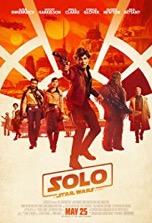
Starring: Alden Ehrenreich
May 2018
Warning! This is NOT a movie review. This is a critique of the film. Intended to initiate a dialogue, the following analysis explores various aspects of the film and may contain spoilers. Views are my own and elaborate on comments that were originally tweeted in real time from the back row of a movie theater @BackRoweReviews. For concerns over objectionable content, please first refer to one of the many parental movie guide websites. Ratings are based on a four star system. Happy reading!
The Premise:
While trying to find his long-lost girlfriend, a brash, young pilot falls in with a band of thieves, a self-styled gambler and a gigantic shaggy creature.
The Evaluation:
In the wake of the polarizing debacle known as The Last Jedi (2017), Star Wars fans from Coruscant to Tatooine were filled with trepidation over the new character spotlight film, Solo: A Star Wars Story. Those concerns were certainly justified in light of Solo’s turbulent genesis; directors Phil Lord and Chris Miller (The Lego Movie) were replaced by Ron Howard six months into the production. Also tempering fan expectations were pre-release rumors that Disney had already written the film off as a loss. Tremors in the Force notwithstanding, the resultant film is a well-acted, well-directed tale that somehow manages to underwhelm despite its lavish ($250 million dollar) production. Not only is Solo a return to the universe we know and love, it’s also a radical departure from the timbre, texture and tropes of every other cinematic SW adventure. First and foremost, Solo is an origin story for one of the most popular characters in the SW panoply, Han Solo (Alden Ehrenreich). We witness Han’s heartbreaking separation from the love of his life, Qi’ra (Emilia Clarke). We have a front row seat for the initial meetings between Han and Chewbacca (Joonas Suotamo), a scene that echoes their reunion in Return of the Jedi (but is far more violent), and Han and Lando Calrissian (Donald Glover). We get to see how Han makes the Kessel Run in less than twelve parsecs and it makes sense…sort of. We also see how Han wins the Millennium Falcon from Lando in a game of sabacc during the anticlimactic denouement. During this disingenuous scene, Han claims that his victory is “fair and square” despite the fact that he owes Lando a ship from when he lost a game earlier in the movie. But perhaps Han’s debt is cancelled after he repeatedly saves Lando’s life. At its core, Solo is a heist movie. Some of the action set pieces are spectacular, like the freight train caper on arctic planet Vandor 1, and the teeth-jarring journey through the Kessel maelstrom, which looks like it was borrowed from the “final frontier.” As a story centered on smugglers, pirates and sinister syndicate tycoons, the look of the film is appropriately grimy, gritty and seedy. Howard takes a bulldozer to Lucas’ “lived-in universe” and then covers it in mud, snow and sand. Though Howard’s monochromatic palette is a sly way of matching style with subject matter, the movie is drab for the sake for being drab. Character’s faces are flat and washed out (with low saturation and little if any contrast) throughout the entire movie and even outdoor scenes are shot during overcast conditions. This dim and dreary aesthetic, which will surely be lauded by critics as a triumph of formalism, actually detracts from the film’s enjoyment since it requires spectators to squint through long stretches of the movie just to make out what’s transpiring onscreen. Still, the directorial virtuosity on display here is astounding, and, in many respects, surpasses the finest efforts of the franchise’s stable of high-profile directors. Though it blazes a bold, new trail for the saga, Solo will go down as more of a miss than a hit. Ironically, as a movie riddled with obligatory allusions, Solo is a heist yarn where the story sabotages itself.
The Breakdown:
Directing- Howard’s insight serves him well in his first foray into the SW universe. His direction is sure-handed and reveals a sensitivity and reverence toward the existing canon that was largely missing from Last Jedi. As an Academy Award-winning director, Howard’s acumen, experience and vision are evident in every frame of the film. Other than the movie’s lighting (see: Cinematography), I have no qualms with Howard’s direction. You might say that the circle is now complete since Howard, who was but a learner in Lucas’ American Graffiti (1973), has taken his first step into Lucas’ much larger world as an undeniable master of his craft. One wonders if the director had a hand in casting Paul Bettany (who co-starred in Howard’s A Beautiful Mind) to play villain Dryden Vos. There can be little doubt that he was involved in casting his brother, Clint, to play Ralakili.
Acting- While on the subject of casting, each actor perfectly embodies the part they were selected to play. Ehrenreich has Han’s insouciant, devil-may-care attitude down pat. Glover, however, pushes his portrayal of Lando too far—Billy Dee Williams was charming and confidant while Glover has too much swagger and is frequently annoying. Woody Harrelson’s Tobias Beckett is one of the most complex and refreshingly realistic characters in any SW film. Clarke also delivers a well-measured performance as a misfortunate young woman forced into servitude by nefarious criminals. Sadly, Thandie Newton’s Val is a disposable side character who has little impact on the story. Another blink-and-you’ll-miss-it part is Lady Proxima (voiced by Linda Hunt), who looks like a supersized version of an Alien chestburster. Longtime SW performers, Warwick Davis and Anthony Daniels (trivia: this is the first SW film sans droids R2-D2 and C-3PO), have brief cameos here. The most interesting new face in the cast is Erin Kellyman, who plays the leader of the Cloud-Riders, Enfys Nest.
Story- Even though Jonathan and Lawrence Kasdan have delivered a unique vision of the SW universe, their script contains some significant problems. Solo is so preoccupied with cramming quotes and references from the earlier (later chronologically) movies into its narrative that the paint-by-numbers plot (i.e., “and here’s where Han meets Chewie,” etc.) consistently upstages the original story concepts. Some elements work well, like the significance of Han’s dice (which is a nice tie-in with Last Jedi), and others don’t, like how Han comes by his last name. It’s clear that the Kasdan’s have a firm handle on both SW lore and crime films. However, their twisty plot is as clear as Mimban mud and the ending is far too obtuse and protracted. And speaking of protracted, the film (which runs 2 hours and 15 minutes), is way too long. Cutting some of the chatting and gambling scenes would’ve shortened the film and made it tighter all at the same time. The gasp-inducing cameo after the final confrontation is the highlight of the movie—the only time we feel any genuine terror. But the thrill quickly abates and the potentially exhilarating storyline goes absolutely nowhere…a microcosmic description of the entire film. Still, Solo is an enjoyable respite from Jedis, lightsaber battles and the Force. There’s more to the SW universe than these elements, as Solo ably demonstrates.
Costumes/Make-up- The costumes are well-tailored, particularly those seen at Vos’ reception and inside the various gambling establishments.
Cinematography- Bradford Young does fine work for the action sequences and establishing shots on the various planets, especially the Falcon’s bumpy landing on Savareen. However, the overall look of the film is bland and lacks color and saturation (see: The Evaluation), a stylistic decision that also falls at the feet of Howard. None of the characters are lit by direct sunlight or any kind of fill light (reflectors) during the entire movie. This flat lighting scheme is unwittingly the perfect choice for a movie almost entirely populated with cardboard characters. And like the characters themselves, the film has no light or dark side…only shades of gray. The lighting design is tantamount to a dimly-lit smuggler’s den, which is fitting when considering the movie’s milieu.
Music- One of the highlights of the film is John Powell’s (Jason Bourne) soundtrack, which is filled with several beautiful, sweeping melodies and makes judicious use of the existing back catalog of SW themes.
Visual FX- Exceptional, as would be expected. The sequence where the squid-like creature is slowly sucked into the maelstrom’s maw is breathtaking. The train hijacking scenes are extremely well storyboarded and executed. In a franchise first, we’re treated to a really nice POV shot from the back seat of the Millennium Falcon as it enters hyperspace. The tableau of a star destroyer surrounded by the maelstrom’s swirling gases is another strong visual composition.
Production Values- Top-notch and top dollar, as would be expected for a Disney tent pole. No problems here.
Movie Magic- Though certain aspects of Han’s origin story and some of the action sequences are thrilling, much of the movie is plodding and dull. Solo’s serious tone makes it a respectable film, but certainly not a fun one. But that’s okay, because this is just A Star Wars Story, not a major trilogy film. As such, Solo has successfully expanded the saga while tiding us over until Episode IX.
Rating: 2 ½ out of 4 stars
Show Dogs (PG)
08/06/18 23:57 Filed in: 2018
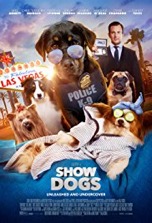
Starring: Will Arnett
May 2018
Warning! This is NOT a movie review. This is a critique of the film. Intended to initiate a dialogue, the following analysis explores various aspects of the film and may contain spoilers. Views are my own and elaborate on comments that were originally tweeted in real time from the back row of a movie theater @BackRoweReviews. For concerns over objectionable content, please first refer to one of the many parental movie guide websites. Ratings are based on a four star system. Happy reading!
The Premise:
In order to track down a gang of animal smugglers, a macho police dog must go undercover as a contestant in a prestigious dog show.
The Evaluation:
The movie opens in NYC, as police dog Max (voiced by rapper Ludacris) prepares to pounce on some animal thieves and rescue a caged panda. A FBI agent named Frank (Will Arnett), who is also working on the case, accidentally thwarts Max’ plan, which allows the criminals to escape. After the botched bust, Max and Frank get thrown together Turner & Hooch (1989) style and are tasked with tracking down the robbers and rescuing the panda. Turning rough-and-tumble Max into a well-groomed, well-mannered canine is just one of the many challenges this unlikely duo must face as they attempt to take a bite out of crime. If the plot sounds familiar, it is. Show Dogs is, at its core, a talking animal version of the Sandra Bullock vehicle, Miss Congeniality (2000). However, whereas Congeniality was a crowd-pleasing romp, Dogs is a witless dud…and that’s putting it mildly. Somewhere along the way, writers started working adult jokes into kids’ movies in order to hold the attention of the parents in the audience. Their justification for employing these guised gags is that they sail right over the heads of younger viewers. This deplorable strategy is a gross underestimation of the impressionable and increasingly savvy children in our society. The truth is, young people are assimilating these crude references whether they completely understand them or not. So here we have a litany of adult jokes shrouded in seemingly innocuous moments of levity. Though subtly delivered in most cases, the movie is filled with double entendres. The movie is also inundated with potty humor, suggestive dialog and even hints of bestiality (Frank engages in a ballroom dance with Max, who stands on his hind legs, and sleeps on the same bed with Max and a Papillon, who remarks that it’s “what nature intended.”) A whole section of the film deals with preparing Max for when the judge will inspect his private areas. As would be expected, this part of the movie generates many unnecessary comments, especially during the bikini wax sequence. And who decided to set this supposedly family film in Las Vegas? Is there a more family unfriendly location the writers could’ve chosen? One character observes that Vegas is marked by luxury and excess, which would seem to indicate how unsuitable it is as the location for a kids’ movie. As the main character, Max is a terrible role model. A fellow contestant sums up the Rottweiler perfectly by stating that Max is cynical, overbearing, can’t work in a team and doesn’t trust anyone. Max’ dialog consists of rude one-liners and inappropriate comments like: “You run like a wiener dog” and “Ah, grow some balls.” Hopefully these examples will serve as a deterrent for those considering this film for their next family night. Parents are strongly cautioned to steer their kids away from this movie and toward more wholesome entertainment. Don’t let anyone fool you…Dogs isn’t a family film.
The Breakdown:
Directing- The movie’s director, Raja Gosnell, is no stranger to the genre (or canines), having helmed Scooby-Doo, Scooby-Doo 2: Monsters Unleashed, and Beverly Hills Chihuahua. The style and lowbrow fare on display here is pretty much the same as in Gosnell’s earlier flicks.
Acting- Despite its pedestrian plot, the film has attracted an array of top-tier talent. In addition to human characters like Mattie (perfectly played by Natasha Lyonne from Orange is the New Black), the movie’s various talking animals are voiced by notables from a number of different entertainment segments, including: actors (Alan Cumming and Stanley Tucci), athletes (Shaquille O’Neal), singers (Jordin Sparks), comedians (Gabriel Iglesias) and reality TV show hosts (RuPaul).
Story- The screenplay, written by Max Botkin and Marc Hyman (not to be confused with wellness physician, Mark Hyman), is mind-numbingly inane, even by talking animal movie standards. The story is merely a loose assemblage of cheesy one-liners (“I knew I smelled bad attitude.”), hyperreal high jinks (like Max bending his way around a moving car Matrix style) and disgusting images (like the spinach, egg shells and whole raw fish smoothie) held together by a contrived plot. From one set of credits to the other, there’s no stoppage of dialog. These characters (mostly animal) just never shut up. Sadly, much of what they say is offensive and doesn’t have any substance whatsoever.
Costumes/Make-up- The NYC and Vegas costumes are appropriate to their settings. Thankfully, dancers and other Vegas performers are adequately clothed in most scenes. The animal costumes, which are difficult to tailor, are also well crafted.
Cinematography- One of the brighter spots in the film is David Mackie’s camera work. The action sequences are well filmed and the pageant scenes, though indebted to the brilliant competition scenes in Best in Show (2000), are enjoyable and lend the movie a measure of reality. Kudos to Mackie for his extensive work with the movie’s many animals, which are never easy to film.
Music- The movie doesn’t really have a score, at least not in the traditional sense—just a lot of up-tempo beats and rap music for the action sequences.
Visual FX- Mostly CGI of dogs talking, making faces and doing unrealistic feats. Nothing groundbreaking.
Production Values- For a supposed kids’ movie, the film has surprisingly high production values. The film makes good use of its locations and appears, in most respects, to be a major studio film even though it was produced by Global Road Entertainment.
Movie Magic- Unless you’re a 6-year-old, you’ll probably find this film unbearably silly.
Rating: 1 ½ out of 4 stars